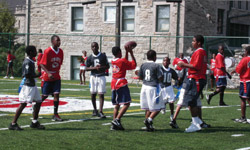Greater Kansas City Local Initiatives Support Corporation (LISC)
by Chris Becicka

Students at the Derrick Thomas Academy tried out the field turf on their new athletic field thanks to a grant from the NFL Grassroots Program.
The Local Initiatives Support Corporation (LISC) is a national non-profit organization which began with 38 cities and 66 rural areas and now has over 300 locations. It has an incredibly appropriate tag line: "Helping neighbors build communities."
Kansas City is home to one of its strongest organizations. Established in 1991, when nine Kansas City Community Development Corporations (CDCs) had created fertile ground for community-based, neighborhood revitalization, the Greater Kansas City Local Initiatives Support Corporation (GKC LISC) has certainly been successful.
"We recognize that neighborhood revitalization is more than just building and renovating houses," says Julie Porter, Program Director. While bringing needed dollars in loans and grants and partnership for this work, LISC also brings technical support and expertise to help make the challenging tasks more doable. The basic premise beneath all the work is that the residents themselves must be involved and responsible. There must be a willingness to think, plan and act strategically--and to be accountable.
GKC LISC has directly invested more than $75 million in grants, loans, and equity through the community development system. It provides a complete range of products such as technical assistance and investment in community development corporations. That assistance includes rigorous organizational assessments, education and training, and performance measurement systems tracking both increased capacity and neighborhood results. It's key, too, points out Diane Patrick, Senior Program Officer, that each dollar raised in Kansas City is leveraged, matched by the national organization. "That makes our every dollar tremendously more useful," she says.
There are a number of key programs that function through LISC. One is Community Development 2000 (CD2000), a collaborative of business, philanthropic and government groups which improves CDC performance and looks at best practice standards and measured results. As a capacity building program, it is sponsored by the Kansas City Community Development Initiative (KCCDI), the largest privately led community development initiative in Kansas City history. Their outcomes include restoring healthy housing markets and physical environments, en-hancing the sense of community and economic vitality, and reducing crime while increasing the perception of safety. The results are clear-cut--and definitely exciting. The crime rate dropped an average of 27% where CDCs operated Community Safety Initiatives, neighborhood programs offered to residents increased by 63%, and real estate values improved significantly in these neighborhoods.
Another program, the American Dream Program, funded by LISC in 1997, helps acquire and rehabilitates single family homes for sale to low and moderate income families. Currently, Kansas City CDCs build approximately 50 affordable homes yearly. There's also the NFL Grassroots Football Fields Program. During the past two years, GKC LISC and the Chiefs have provided $175,000 to the Boys and Girls Clubs of Kansas City and Northland Neighborhoods Inc. to build youth football fields--and another one is going in the Heritage area soon. "Parks and athletic fields serve as tremendous assets to neighborhoods for recreation, relaxation and education. They contribute to the quality of life, especially for our youth," states Julie Porter.
It's those kind of improvements that tell folks at LISC that hard work, persistence, and neighbors working together really work. When asked what LISC's greatest accomplishment is, Diane Patrick says, "I can only point to an entire landscape of achievements," before she starts a long list including the Brush Creek Corridor, the new homes along the Paseo, the continued steady growth at 18th and Vine, the RAMP program in midtown which provided funding for neighbors to fix up their homes, the Parkway Redevelopment Plan, the loft apartments going up in Kansas City, Kansas, the Mission Clifts program around KU Medical Center which is bringing in new housing . . . she barely takes a breath before inventorying even more.
It doesn't matter whether you call it urban renewal, core redevelopment, reversed disinvestment, or plain old community progress. What LISC really means is revitalizing neighborhoods once decayed beyond hope--house by house, block by block.